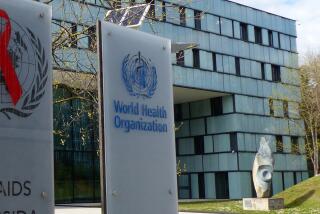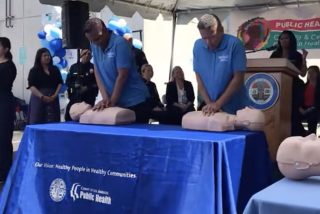Choking Rx: Slapping Out, Heimlich In
Slaps on the back as the first step in emergency assistance for choking victims are soon to be dropped as recommendations of the American Red Cross and American Heart Assn., the two groups said Monday, apparently bringing to an end several years of controversy over whether the blows are life-saving or life-threatening.
The change--which will require massive revision and reprinting of hundreds of thousands of pieces of public education material, from posters to pamphlets--will mean that the single treatment of choice for a choking victim is what is commonly called the Heimlich Maneuver.
At the moment, both the Red Cross and heart association recommend that a rescuer strike a choking victim on the back four times before attempting the Heimlich Maneuver.
End of a Dispute
But for years, Dr. Henry Heimlich, the maneuver’s developer, has crusaded against the back blows, arguing they are unsafe and may, in fact, cause a piece of food or other foreign body to lodge more firmly in the throat. The dispute between Heimlich and the Red Cross--in particular--had degenerated into a personality conflict in the view of many observers.
Ten days ago in Dallas, however, at an annual American Heart Assn. conference on cardiopulmonary resuscitation techniques, a truce apparently was reached. The conference issued a preliminary recommendation--which both the association and the Red Cross said in statements Monday is virtually certain to be made final--that the back blows be dropped and the Heimlich Maneuver, which will be called by its generic name, the “abdominal thrust,” remain as the single recommended treatment for life-threatening choking.
In another development, the conference also produced a preliminary recommendation that both national groups begin advocating use of the Heimlich Maneuver in emergency treatment of drowning victims. That finding, however, is likely to undergo extensive additional debate. The heart association, which confirmed the impending change in choking victim rescue techniques, insisted that application of the maneuver to drowning cases was not yet the final position of the association.
To Simplify Training
The heart association and the Red Cross both said the change is being made only to simplify training of would-be rescuers and eliminate confusion that has sometimes surrounded the sequence of four back blows followed by thrusts to the abdomen. Both groups insisted the current practice is safe.
In the Heimlich--or abdominal thrust--maneuver, a rescuer places his arms around a choking victim from behind and clasps his hands together at the bottom of the rib cage, somewhere between the navel and the lower ribs. The rescuer then gives one or more quick upward thrusts, hoping to dislodge a food morsel or other foreign body in the throat. The maneuver can be done repeatedly, if necessary. Current Red Cross and heart association guidelines call for as many as six attempts.
A heart association spokesman said the change was being made “to assure uniformity and ease of training and retention” by laymen who are taught cardiopulmonary resuscitation. The recommendation will be reviewed by committees of experts in both organizations and, if adopted as expected, the change in policy will be published in the Journal of the American Medical Assn.
Both organizations also said that if, as expected, the change in technique is formally accepted several weeks from now, it will mean massive revisions in extensive teaching materials currently distributed to the public nationwide.
In a telephone interview from his headquarters at Xavier University in Cincinnati, Heimlich expressed delight that his view had apparently prevailed, and he expressed hope that personal elements that have dominated the debate can be forgotten. “I’m just glad that more lives will be saved,” Heimlich said.
Focus of Controversy
The personality dispute centered in part around the association of Heimlich’s name with the thrust maneuver. Critics have charged that Heimlich was inappropriately interested in perpetuating the personal name recognition--a contention Heimlich has consistently denied.
The issue had festered in medical circles for years until last October when, at a Chicago conference, Heimlich charged the Red Cross with responsibility for taking lives that could be saved by continuing to recommend back blows. In the wake of the Chicago episode, Dr. Lewellys Barker, the Red Cross CPR director, issued a statement to The Times saying that he was willing to meet to try to resolve the dispute personally with Heimlich. Heimlich said the public airing of the controversy and Barker’s statement paved the way for resolution.
In a telephone interview, Barker said he expects final approval of the change to be routine. He said the Red Cross will begin work soon on revisions on hundreds of different publications so the changes can be distributed immediately after formal publication. “I certainly don’t anticipate any significant change in the preliminary recommendations,” he said, “and we expect to go along with them.”
Barker emphasized that the Red Cross still does not believe back blows to be unsafe. “We think the abdominal thrust has something of an edge,” he said. “It is at least as good, very probably better. But we don’t see great urgency or emergency in making the change. We don’t think there is tremendous public health risk in using what people have been taught in the past.”
More to Read
Sign up for Essential California
The most important California stories and recommendations in your inbox every morning.
You may occasionally receive promotional content from the Los Angeles Times.










